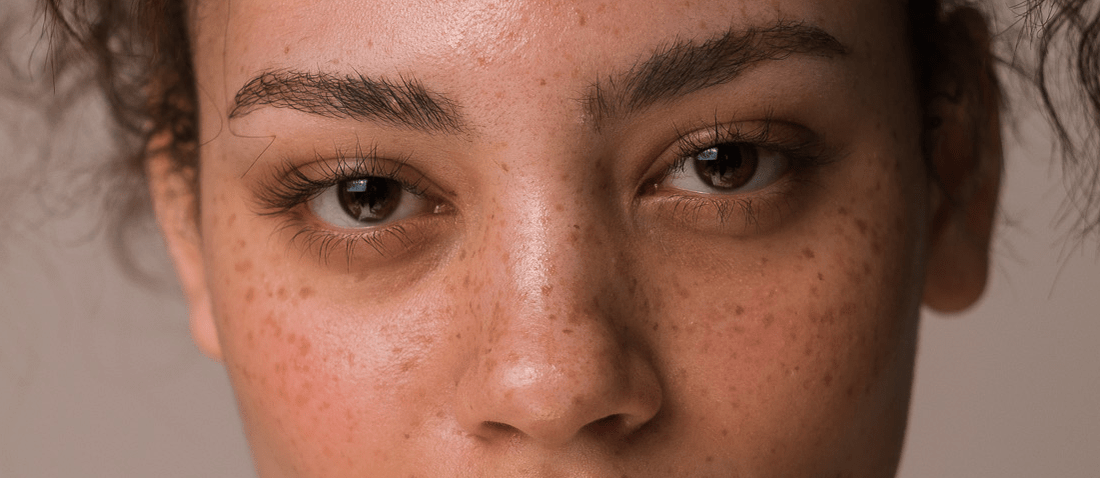Every summer, as the days get longer and we spend more time outside, you might notice spots popping up on your skin. While they may look cute dappling your face and arms, you might wonder if they’re something to worry about.
These spots are likely either freckles or sun spots—and in either case, they’re typically not harmful. However, understanding their causes and characteristics, as well as effective treatment and prevention strategies, can help ensure you’re taking the best care of your skin health possible.
So, sun spots vs freckles: what’s the difference?
WHAT ARE FRECKLES?
Freckles, those small, dark spots that generally appear on areas of skin that are more prone to sun exposure, like your:
- Cheeks
- Shoulders
- Arms
They often make their grand entrance in the summer and can fade over time. They can also vary in color from red or tan to light or dark brown.
But what exactly causes these spots? Freckles are often determined by genetics. That is to say, you can be genetically more likely to get freckles after being exposed to sunlight.
Does their appearance after sun exposure mean that freckles are harmful?
Fortunately, no. Freckles are merely regions of the skin where melanocytes, those cells that gift your skin with extra melanin—your skin’s natural pigmentation, are more active. They’re not considered to be sun damage but rather a symbol of sun protection. In other words, they are almost like your own sunscreen that appear to help further shield your skin from the sun’s ultraviolet (UV) rays.
WHAT ARE SUN SPOTS?
Sun spots are those flat, brown spots on the skin also often referred as age spots, liver spots, and solar lentigines.
Like freckles, they tend to appear on areas of skin that receive the most sun exposure. While you can be genetically more likely to get sun spots, anyone can develop them from prolonged sun exposure. Thankfully, similarly to freckles, sum spots are not generally harmful.
So, what makes these sun spots different?
Sun spots typically appear with age, developing from sun exposure over time, and why they’re commonly called age spots. They’re can be formed from both UV ray light from the sun, as well as artificial UV light used in technology such as tanning beds.
While medical treatment is often unnecessary, there are options for lightening or removal, such as chemical peels, laser treatment, and intense pulsed light therapy. Additionally, if you notice that your sun spots have changed in appearance or present as black in color, it’s best to consult a dermatologist to rule out melanoma, a type of skin cancer.
SUN SPOTS VS FRECKLES: A SIDE-BY-SIDE COMPARISON
While freckles and sun spots are closely related, there are a few key differences to keep in mind:
Size Matters
Although they can be larger, freckles tend to only be 1 to 2 mm in size.
Sun spots, on the other hand, can range from millimeters to centimeters in diameter. They also often develop in clusters, which contributes to their larger size.
Age Chronicles
Freckles tend to develop more frequently in young children and throughout young adulthood but often fade in the winter and over time.
While sun spots can develop earlier in life, they’re most often seen in adults over 50 and rarely fade.
Sun Damage
Freckles are not considered sun damage, but rather your skin’s natural sunscreen. They’re a good indicator of where your skin is receiving the most UV light and where you should apply more sunscreen.
Sun spots are examples of sun-damaged skin, as they develop from repeated sun exposure. Still, they’re generally harmless, and adding in a sun & dark spot correcting serum can help reduce inflammation and hyperpigmentation spots. However, if you’re ever concerned about spots, consider consulting a dermatologist.
Genetic Blueprint
While sun exposure activates the appearance of freckles, it’s the combination of sun and genetics that causes freckles to develop.
In contrast to freckles, sun spots are not directly tied to genetics. Anyone can develop sun spots regardless of their genes.
HOW TO PROTECT YOUR SKIN
There are many factors that differentiate freckles and sun spots, but they can both be prevented with proper sun protection. This means being liberal in applying sunscreen, wearing protective clothing, and limiting time in the sun. Our skin in the largest organ on our body and we should be protecting it as best we can.
Applying sunscreen
The best way to protect your skin from sun damage is to wear sunscreen daily—even on cloudy days. Grab our broad spectrum SPF 30 face sunscreen, and apply a thick layer to exposed areas of skin, particularly your face and neck. If you’re using another brand, make sure your SPF is at least 30 and reapply every two hours or more frequently if needed (e.g. if you’re sweating a lot or swimming).
Limiting time in the sun
You can further protect your skin by limiting time in direct sunlight, especially during the peak hours of 10 a.m. and 2 p.m. Whenever possible, try sitting in the shade—your skin will thank you.
Wearing protective clothing
While limiting your time in the sun may not always be possible. Consider wearing pieces of clothing that provide your skin with an additional layer of coverage, like long-sleeved shirts, sunglasses, and wide-brimmed hats.
Avoiding artificial UV light
Different technologies, such as tanning beds, and UV nail lights that expose you to prolonged artificial UV light can be the cause of unnecessary sun damage.
FOR YEAR-ROUND SKINCARE, TRUST SEVEN:THIRTY
Regardless of whether you’re experiencing sun spots or freckles, it’s important to monitor your skin and protect its long-term health by applying a daily sunscreen, wearing protective clothing when possible, and avoiding prolonged UV exposure.
And for any other skin concerns?
Try our skin consult to discover a personalized skincare routine. Whether that means introducing a peptide face moisturizer or soothing irritation with a hydrating antioxidant facial serum, Seven:Thirty is here to help you feel confident in your skin.
Sources:

